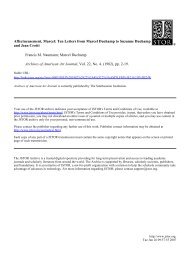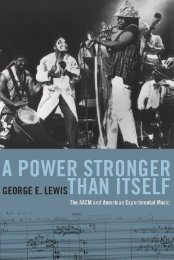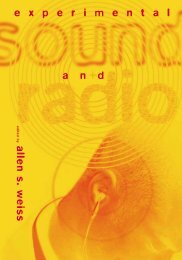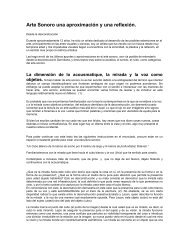- Page 2 and 3: Sonic Interventions
- Page 4 and 5: Sonic Interventions Editors Sylvia
- Page 6: Mission Statement Intersecting: Pla
- Page 9 and 10: 211 Between Orality and Literature:
- Page 12 and 13: Sonic Interventions: An Introductio
- Page 14 and 15: Thamyris/Intersecting No. 18 (2007)
- Page 18 and 19: Thamyris/Intersecting No. 18 (2007)
- Page 20 and 21: Seidler’s key interest clearly do
- Page 22 and 23: Thamyris/Intersecting No. 18 (2007)
- Page 24 and 25: Thamyris/Intersecting No. 18 (2007)
- Page 26 and 27: Notes 1. Sounding Out in 2002, Soun
- Page 28: Quayson, Ato. Strategic Transformat
- Page 32 and 33: The New International of Rhythmic F
- Page 34 and 35: Thamyris/Intersecting No. 18 (2007)
- Page 36 and 37: Thamyris/Intersecting No. 18 (2007)
- Page 38 and 39: Thamyris/Intersecting No. 18 (2007)
- Page 40 and 41: Thamyris/Intersecting No. 18 (2007)
- Page 42 and 43: Thamyris/Intersecting No. 18 (2007)
- Page 44 and 45: Thamyris/Intersecting No. 18 (2007)
- Page 46 and 47: Thamyris/Intersecting No. 18 (2007)
- Page 48 and 49: epeating ground and anarchic disrup
- Page 50 and 51: Thamyris/Intersecting No. 18 (2007)
- Page 52 and 53: Notes 1. Lord Invader, Calypso in N
- Page 54 and 55: Williams’s romance with sound, mi
- Page 56 and 57: Dumas. Ed. Eugene B. Redmond. Minne
- Page 58 and 59: ABSTRACT Thamyris/Intersecting No.
- Page 60 and 61: Thamyris/Intersecting No. 18 (2007)
- Page 62 and 63: Thamyris/Intersecting No. 18 (2007)
- Page 64 and 65: Thamyris/Intersecting No. 18 (2007)
- Page 66 and 67:
Thamyris/Intersecting No. 18 (2007)
- Page 68 and 69:
etween song, music and spoken texts
- Page 70 and 71:
German Andreas Hofer, You pearl of
- Page 72 and 73:
(housing estate). 34 Thus, the spat
- Page 74 and 75:
Thamyris/Intersecting No. 18 (2007)
- Page 76 and 77:
Ehrenfeuer (memorial flame) had alr
- Page 78 and 79:
Thamyris/Intersecting No. 18 (2007)
- Page 80 and 81:
Thamyris/Intersecting No. 18 (2007)
- Page 82 and 83:
16. Historian E.P. Thompson cites t
- Page 84 and 85:
Verlegenheit? Ein Held? (1983: 1),
- Page 86:
Merleau-Ponty, Maurice. The Phenome
- Page 89 and 90:
of artists dying in childbirth, wis
- Page 91 and 92:
conceptual field in which it origin
- Page 93 and 94:
“The Unlocking” begins with a s
- Page 95 and 96:
Paying sexual ties for few and untr
- Page 97 and 98:
the men cannot hear Rucker’s voic
- Page 99 and 100:
Rucker is careful to signal other w
- Page 101 and 102:
Notes 1. In “ ‘A Hard Rain,’
- Page 104 and 105:
ABSTRACT Thamyris/Intersecting No.
- Page 106 and 107:
Thamyris/Intersecting No. 18 (2007)
- Page 108 and 109:
Thamyris/Intersecting No. 18 (2007)
- Page 110 and 111:
Thamyris/Intersecting No. 18 (2007)
- Page 112 and 113:
Thamyris/Intersecting No. 18 (2007)
- Page 114 and 115:
I am reminded here of Khatibi’s i
- Page 116 and 117:
Notes 1. This is particularly valid
- Page 118:
Paul Patton and John Protevi. Londo
- Page 121 and 122:
not be ignored in analysis. The plo
- Page 123 and 124:
“True. Except I heard it yesterda
- Page 125 and 126:
parts of Lauren’s lines and then,
- Page 127 and 128:
eaders we learn from Mariella Chapm
- Page 129 and 130:
Mr. Tuttle as a symptom At first, t
- Page 131 and 132:
173, Di Prete 89). But Di Prete’s
- Page 133 and 134:
for the body artist, which is to in
- Page 135 and 136:
throw it over the edge of his curta
- Page 137 and 138:
is the attempt to create a “da”
- Page 139 and 140:
writes, “the incantation.” Here
- Page 141 and 142:
submits: death. One could even say
- Page 143 and 144:
Notes 1. The thoughts and theses I
- Page 145 and 146:
Ed. James Strachey. London: The Hog
- Page 148 and 149:
ABSTRACT Thamyris/Intersecting No.
- Page 150 and 151:
Thamyris/Intersecting No. 18 (2007)
- Page 152 and 153:
Thamyris/Intersecting No. 18 (2007)
- Page 154 and 155:
Thamyris/Intersecting No. 18 (2007)
- Page 156 and 157:
psychoanalysts as well. Analyses of
- Page 158 and 159:
Thamyris/Intersecting No. 18 (2007)
- Page 160 and 161:
Thamyris/Intersecting No. 18 (2007)
- Page 162 and 163:
of this type of high voice to hyste
- Page 164 and 165:
Thamyris/Intersecting No. 18 (2007)
- Page 166 and 167:
9. Study models of harmony, form, t
- Page 168 and 169:
Rethinking Music. Eds. Nicholas Coo
- Page 170:
Performing Subjectivity: Literature
- Page 173 and 174:
surroundings, themselves, or figmen
- Page 175 and 176:
The relative fixity of the A sectio
- Page 177 and 178:
The narrator describes Armstrong’
- Page 179 and 180:
The form that allows the narrator t
- Page 181 and 182:
self-assertion - his capacity to sa
- Page 183 and 184:
a division between the recognizable
- Page 185 and 186:
solid or tight identification betwe
- Page 187 and 188:
the understanding of Armstrong towa
- Page 189 and 190:
when the narrator tries to grasp th
- Page 191 and 192:
Notes 1. I would like to thank Kath
- Page 194 and 195:
ABSTRACT Thamyris/Intersecting No.
- Page 196 and 197:
Thamyris/Intersecting No. 18 (2007)
- Page 198 and 199:
Thamyris/Intersecting No. 18 (2007)
- Page 200 and 201:
Thamyris/Intersecting No. 18 (2007)
- Page 202 and 203:
Leroi Jones) argued in Blues People
- Page 204 and 205:
Thamyris/Intersecting No. 18 (2007)
- Page 206 and 207:
Thamyris/Intersecting No. 18 (2007)
- Page 208 and 209:
Notes 1. Baldwin 2. Further citatio
- Page 210:
Moten, Fred. In the Break: The Aest
- Page 213 and 214:
This story, now known as the Alida
- Page 215 and 216:
women: a notoriously cruel slave mi
- Page 217 and 218:
adio makes for a voice/body-split t
- Page 219 and 220:
In this way slaves could reappropri
- Page 221 and 222:
Weheliye asserts these “possibili
- Page 223 and 224:
Christian couple who become her gua
- Page 225 and 226:
While mastering Dutch and living un
- Page 227 and 228:
In school she is taught to read boo
- Page 229 and 230:
Her status as mulatta carries with
- Page 231 and 232:
The folktale’s oral performances
- Page 233 and 234:
Notes 1. In his highly influential
- Page 235 and 236:
soort…’ Ze kuchte, keek me erns
- Page 237 and 238:
46. “ ‘Zie je deze hand? Meneer
- Page 239 and 240:
Reed, Ishmael. Mumbo Jumbo. Garden
- Page 242 and 243:
ABSTRACT Thamyris/Intersecting No.
- Page 244 and 245:
Thamyris/Intersecting No. 18 (2007)
- Page 246 and 247:
Dakar and Paris. Daara J’s music
- Page 248 and 249:
Thamyris/Intersecting No. 18 (2007)
- Page 250 and 251:
Thamyris/Intersecting No. 18 (2007)
- Page 252 and 253:
Thamyris/Intersecting No. 18 (2007)
- Page 254 and 255:
Thamyris/Intersecting No. 18 (2007)
- Page 256 and 257:
Thamyris/Intersecting No. 18 (2007)
- Page 258 and 259:
Thamyris/Intersecting No. 18 (2007)
- Page 260 and 261:
Notes 1. 2 Feb 2005 �http://www.o
- Page 262 and 263:
25. For more details on Roma histor
- Page 264 and 265:
Nieto, Osacar. “Evolution and Rev
- Page 266 and 267:
Hip Hop Nation and Gender Politics
- Page 268 and 269:
Thamyris/Intersecting No. 18 (2007)
- Page 270 and 271:
or Tel Aviv City Team. All of the i
- Page 272 and 273:
Thamyris/Intersecting No. 18 (2007)
- Page 274 and 275:
Thamyris/Intersecting No. 18 (2007)
- Page 276 and 277:
Thamyris/Intersecting No. 18 (2007)
- Page 278 and 279:
Thamyris/Intersecting No. 18 (2007)
- Page 280 and 281:
Thamyris/Intersecting No. 18 (2007)
- Page 282 and 283:
But who cares, when your idol, Your
- Page 284 and 285:
Notes 1. Full Frame Documentary Fil
- Page 286:
Marciniak, Katarzyna. Alienhood: Ci
- Page 289 and 290:
Kingston, Jamaica. These attract a
- Page 291 and 292:
Figure 2 Screen, dancers and camera
- Page 293 and 294:
Figure 3 Dancehall Queen Stacey at
- Page 295 and 296:
illo tempore, ab origine” (Eliade
- Page 297 and 298:
The present investigation is concer
- Page 299 and 300:
Figure 5 Stone Love Set under repai
- Page 301 and 302:
One important feature of the relati
- Page 303 and 304:
elationship. As Bateson explains:
- Page 305 and 306:
Notes 1. This paper is part of a la
- Page 307 and 308:
34. DJ Squeeze (a.k.a. Mr Glenworth
- Page 309 and 310:
—. Cut ‘n’ Mix: Culture, Iden
- Page 312 and 313:
The Contributors Carolyn Birdsall i
- Page 314 and 315:
Index A Abbate, Carolyn, 154, 160,
- Page 316 and 317:
Clayton, Martin, 152, 166 Clément,
- Page 318 and 319:
Glinka, Michail, 259 Glissant, Edwa
- Page 320 and 321:
Laitmon, Steven, 208 Lakoff, George
- Page 322 and 323:
Pérez-Torres, Rafael, 44, 53, 56 P
- Page 324 and 325:
T Tabari, 110 Tarantino, Quentin, 9







